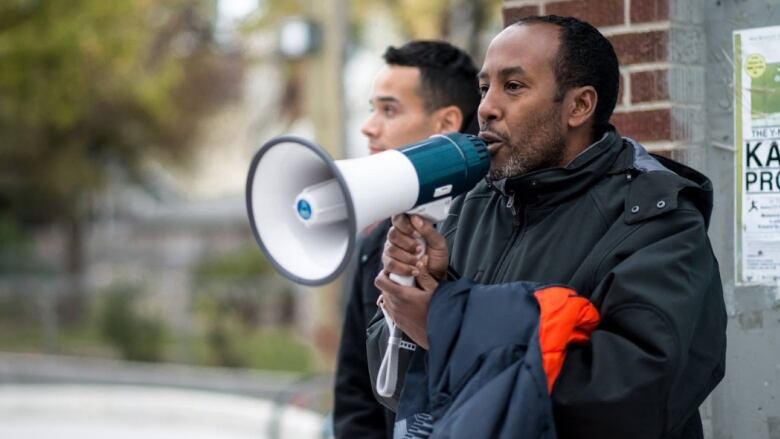People of colour know they're hardest hit by COVID-19 in Manitoba. Now they want action
Dismantle language barriers, target people of colour for vaccines, critics say

It doesn't surpriseAbdikheir Ahmed thatracializedpeople arebearing the brunt of Manitoba's pandemic pain.
He remembers a late-winter conversation with a white friend who lives in Winnipeg's suburbs.
"I was asking this friend of mine whether he knew anyone in his circle who had COVIDand he could not count more than five people," said Ahmed,executive director of Aurora Family Therapy Centre andformer director of Immigration Partnership Winnipeg.
"At that point, I knew more than 200 people who had contracted COVID.People whoare clients of my work, as well as people who I know personally."
Ahmed, a long-time advocate for newcomers, said Monday'srelease of race-based data from the provincial governmentvalidated what he already knew: COVID-19 hasdisproportionately hurtminority groups the most.
The numbers are stark: the infection rate among southeast Asiansincluding ethnic Vietnamese, Lao, Thai andCambodian people was a staggering 21.7 times greater than the rate for white peoplefromMarch 31 toJune 7 of this year.
Higher vulnerability to the pandemic
African Manitobans had infection rates8.7 times the rate of white Manitobansduring the same time span, while south Asians people originally from India and Pakistan had eight times the infection rate.
The government had previously released race-based data, but Monday's information showed the gap created by the pandemic's impact on white and non-white Manitobans widened this spring.
Ahmed said racialized Manitobansmore likely to be oflower-income means, working front-line jobs and livingin crowdedhomesare more vulnerable to the effects of COVID-19.
"Most of these populations, if one person caught COVID, itruns across the whole family," said Ahmed.
"If someone in Waverley Heights caughtCOVID, they have a place to isolate. They can stay in the basement for the rest of the 14 days."
Kim Le, who runs a Vietnamese restaurant, Banh Mi Khanh Hoa, and a travel agency, said the report's findings worry her. People from Vietnam are among the southeast Asianswhose infection rate was more than 20 timesgreater than white Manitobans.
"I'm very concerned," she said, "not only for me, but for our family, for the community, for everyone."

Ray Aulakh, who works forthe Punjabi radio station, Radio Awaz, said there is not enough tailored information in Punjabiabout the virus or vaccines.
Some people do not understand the seriousness of the virus, nor the accessibility ofpaid sick leave andvaccines.
Confused callers
"We have been continually getting calls from people on whether they are eligible for vaccination or not. If they are students or on work permit, if they don't have a health card, how could they get a vaccination?" he said.
"There is not much information available in the public domain."
Aulakh said there is also a myth circulating that people from India are more immuneto the virusbecause they wereexposed to more infectious diseases growing up.
He wants the Manitoba government to do a better job translating public health information to Punjabi.

More members of his community are getting vaccinated, but he said there's still work to do. Of his 26 colleagues in the multiple jobs he works, only heand one other co-worker arevaccinated, he said.
Louise Simbandumwe, a member of theImmigration Matters in Canada coalition, said she's encouraged with the province communicating the ways it can improve.
The province acknowledged Monday it wouldalter any future vaccination strategy. The reliance on an age-based rollout was detrimental to protecting BIPOC people, the government report stated.
It's clear from the report that if "vaccinations had been available based on those risk factors [affecting people of colour] that would have reduced the inequities that we saw around whogot COVID," she said.
Fortunately,Simbandumwesaid, the province recognized the risk factors facing First Nationspeoples months ago and made each of them eligible for a vaccine at the same time asManitobans 20 years their senior.
But overall, the dependency on an age-based rollout for vaccinations shows Manitoba was late to waking up to the detrimental effects of that decision, Ahmed said.
"They treated everybody else like the white person who lived in the suburbs of the city by basing it on ages," he said.
Manitoba has recently been tailoring its vaccination strategy to include more pop-upclinics organized by local groups to target areas with lower immunization rates
In the longer-term, Ahmedsaid Manitoba should address some of thestructural issues holding back people of colour, such as their housing and wages.
With files from Bartley Kives












_(720p).jpg)


 OFFICIAL HD MUSIC VIDEO.jpg)
.jpg)



























































































